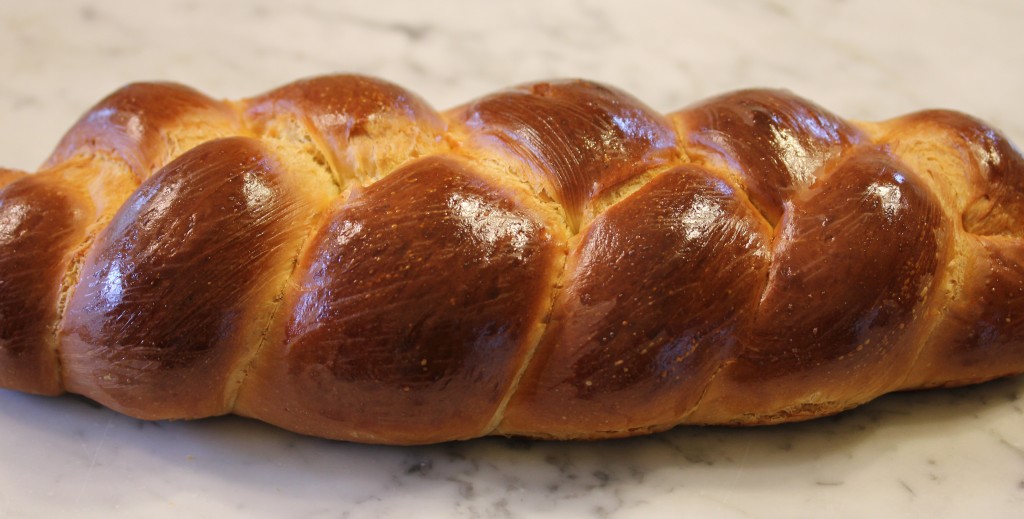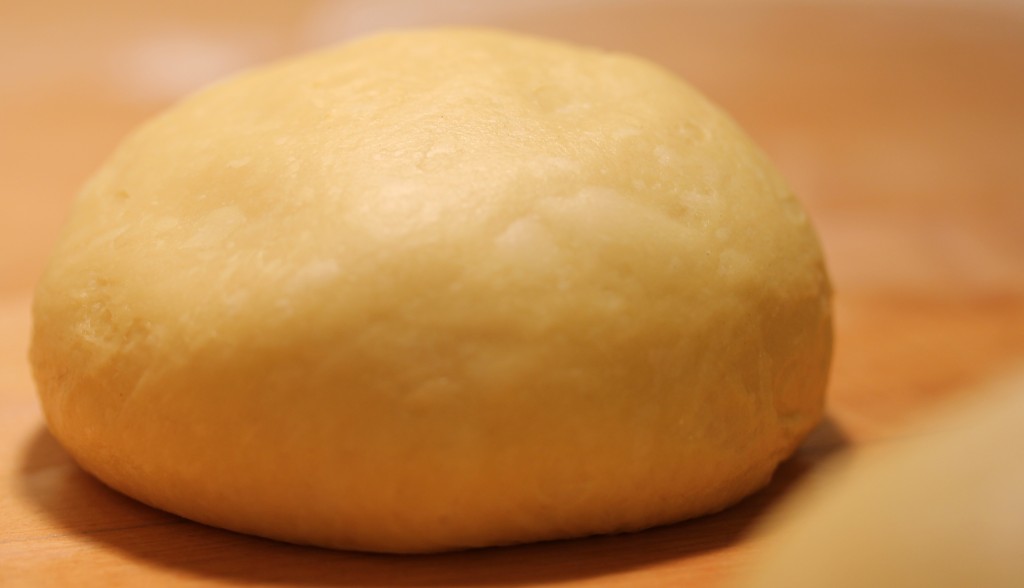When I started baking bread, Brian asked me about his childhood favorite.
“It was long. And twisted. And eggy.”
“Challah!” I said.
“No, the Swedes called it Egg Twist Bread.”
“It’s called challah, you’re getting challah,” I said. It wasn’t his fault. He grew up in Oregon which was, and still may be, ethnically deprived. I actually believe his “Swedish” baker was probably not named “Swenson.”
We bake challah often, enjoying its rich texture and egg flavor. Yes, Brian will use it to make a BLT, and quite frankly it’s delicious.
This recipe, from Sarabeth Levine of Sarabeth’s, creates tight loaves that are perfect morning toast. The bread is eggy yellow, dense but not dry, and filled with flavor that will remind you of childhood bakeries. Maybe from Brooklyn, maybe from Portland.
Challah
Yield: 2 loaves
Ingredients:
- 1 ounce (2 packed tablespoons) compressed yeast or 3 ½t teaspoons active dry yeast
- ¼ cup mild honey, such as orange blossom
- 1 cup cold water
- 2 large eggs plus 2 large egg yolks
- ¼ cup corn oil, preferably cold-pressed, or other vegetable oil, plus additional for the bowl
- 4½ cups unbleached all-purpose flour, as needed
- 1½ teaspoons fine sea salt
- 1 large egg, beaten with a hand blender for glaze
Preparation:
Crumble the compressed yeast finely into the bowl of a heavy-duty stand mixer. Add the honey and let stand until the yeast gives off some moisture, about 5 minutes. Whisk well to dissolve the yeast. Add the water, the 2 eggs, the yolks, and oil and whisk again. (If using dry yeast, sprinkle the yeast over ¼ cup warm, 105° to 115°F, water in a small bowl. Let stand for 5 minutes to soften the yeast, then stir to dissolve. Pour into the mixer bowl. Add ¾ cup cold water, the honey, the 2 eggs, the yolks, and oil, and whisk to combine.)
Attach the bowl to the mixer and fit with the paddle attachment. On low speed, gradually add half of the flour, and then the salt. Gradually mix enough of the remaining flour to form a soft, rough dough that cleans the bowl. Replace the paddle attachment with the dough hook. Knead on medium-low speed until the dough is smooth, soft, and elastic, about 6 minutes.
Transfer the dough to a lightly floured work surface. Knead briefly to check the dough’s texture. It should feel slightly sticky, but you can knead in a little more flour if necessary. Lightly oil a large bowl. Shape the dough into a ball and place, smooth side down, in the bowl. Turn to coat the ball with the oil, ending with the smooth side up. Cover the bowl tightly with plastic wrap. Let stand in a warm place until doubled in volume, about 1 ½ hours.
Working carefully to preserve the dough’s light and puffy texture, turn the dough out onto a clean, unfloured work surface. Do not knead the dough. Gently shape the dough into a thick rectangle and cut the dough into 6 equal pieces. For the best results, weigh each piece on a scale.
In order to roll the dough into ropes for braiding, there must be some traction between the dough and the work surface. The tiniest bit of flour will make the surface too slick. To remedy this, scrape your work surface completely clean. Using a damp kitchen towel, wipe a very thin film of water on the work surface. Working with one piece of dough at a time, shape into a thick cylinder. Starting at the center and working outward, roll the dough back and forth on the work surface, pressing down on the dough at the same time, slowly moving your hands apart as you roll until the dough is stretched into a 13-inch-long rope, with the center of the rope plumper than the two ends. Repeat with the other 5 ropes. As the ropes are formed, cover them loosely with plastic wrap.
Line two half-sheet pans with parchment paper. Vertically line up 3 ropes next to each other. Begin the braid from the center to one bottom end, dropping the ropes loosely into place without stretching them. When you have finished half of the braid, pinch the ends together. Flip the dough over with the unbraided ropes facing you. Braid from the center to the other end, and pinch the ends together. Turn the dough over again, and transfer to a prepared pan. Be sure that the ends of the loaf are pinched and the points are tucked under. Repeat with the other 5 ropes of dough and transfer to a second prepared pan.
Choose a warm spot in the kitchen for the proofing. Slip each pan into a tall “kitchen-sized” plastic bag, place a tall glass of very hot water on each pan to keep the plastic from touching the dough. Tightly close each bag, trapping air in the bag to partially inflate it. Let stand until the braids look quite puffy and seem a bit more than doubled in volume, 45 to 60 minutes. Meanwhile, position racks in the center and top third of the oven and preheat to 375°F. Remove the glass from each pan, then the pans. Brush the top of each braid lightly but thoroughly with the beaten egg.
Bake for 15 minutes. Switch the position of the breads from top to bottom and front to back. Reduce the oven temperature to 350°F and continue baking until the loaves are golden brown and the bottoms sound hollow when tapped with your knuckles, about 50 minutes. If the loaves seem to be browning too deeply, cover them loosely with aluminum foil. Transfer the loaves to a wire rack and cool completely.





Suzi, after Passsover I will send you the recipie I’ve been working on for Challah. I’m going to try it once more but adding some gluten. Mine isn’t as stringy as the Great Harvest Bakery in Herndon – they make the best I’ve ever had. I use lots of yolks with sugar. Remind me if I forget.
This is my first time on the blog…thanks!!